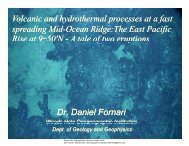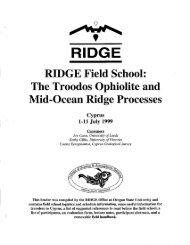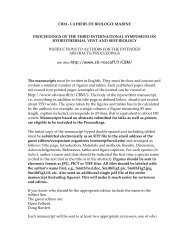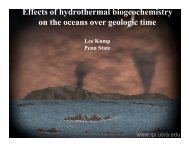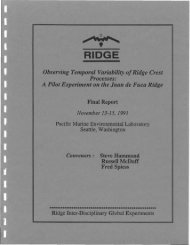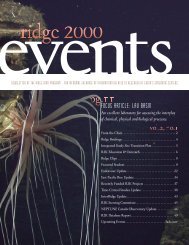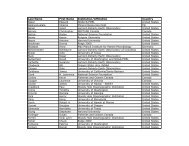Create successful ePaper yourself
Turn your PDF publications into a flip-book with our unique Google optimized e-Paper software.
near future, it may be possible to design free swimming vehicles<br />
to conduct complex sampling and monitoring operations of hot<br />
spring emanations. Eventually, advanced robotics, artificial<br />
intelligence, and utilization of natural heat for power might<br />
lead to independent and long-term ocean bottom instrument<br />
packages.<br />
A later phase should include detailed studies of specific<br />
sites. We would anticipate that three sites should be chosen<br />
for initial study, identified as different based on our present<br />
knowledge of hydrothermal systems. We recommend that one of the<br />
sites should be a classic black-smoker, bare-rock site, with<br />
relatively small sulfide deposits, a second location should be<br />
selected on a sedimented ridge crest with more massive<br />
mineralization, and a third should include a low temperature<br />
hydrothermal system, possibly located off of the ridge axis.<br />
At these locations, intensive studies would include detailed<br />
geological mapping, determination of the temporal variability of<br />
the flow, testing of new instrumental configurations, and<br />
limited drilling. The contrasts between the sites will allow<br />
characterization of the fundamental differences between small<br />
(young?) and large (old?) bare rock systems, and between those<br />
and the sediment-hosted systems.<br />
Other kinds of targets can be envisaged, such as vents with<br />
salinity significantly above or below that of seawater, with<br />
unusually high or low temperature venting, back-arc or island<br />
arc terrains, unusually shallow water and deep water sites, and<br />
regions associated with seamount volcanos.<br />
As the exploration and initial seafloor experimentation<br />
phases, and subsequent long-term studies, develop and become<br />
more mature after the first few years, increased knowledge<br />
should enable the selection of one or more sites which have the<br />
most promise of augmenting our understanding of the sub-seafloor<br />
systems. At these sites, measurement and sampling should be<br />
done with the full array of techniques which are then available.<br />
Our goal is no less than the comprehensive description of how a<br />
sub-seafloor hydrothermal system is working, enabling us to<br />
estimate those characteristics which are most critical for<br />
determining the variability and similarity among all such<br />
systems. Only then can we make confident predictions of other<br />
systems not yet studied in detail or only partially<br />
characterized, and the extent to which they contribute to the<br />
overall heat and mass transfers on the entire mid-ocean ridge.<br />
44






